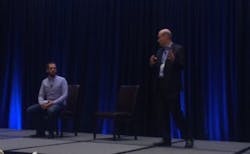It was assumed that 3D printing would forever be pinned to pumping out product prototypes. But that limiting idea is getting squashed by real world examples of the technology being used to produce finished goods.
Two examples of the evolution of additive manufacturing were presented at The Automation Conference & Expo in Chicago last month, underscoring the attitude that this advanced technology is perfected and production-ready.
Michael Corr, who is the founder of manufacturing consulting company DuroLabs, spoke of his experience using 3D printing technology while working as the director of engineering at a commercial drone company. The company was focused on providing clients with aerial data. The business model was one in which the company would lease industrial unmanned aerial vehicles (UAVs) to the customer, and, once the drones were returned, they’d sell the image data back in a recurring revenue model.
The company was trying to figure out what customers needed in terms of features, so there was a lot of experimentation with drone configuration to find the right weight ratio between the battery, motor and propellers to create the ideal flight time. There was also the issue of gravity. Drones can fall out of the sky and parts need to be replaced.
These two scenarios created the perfect set up for 3D printing, Corr said. Using three Stratasys 3D printers operating 24/7 enabled the company to build multiple drone parts, from camera and battery mounts to the internal frame and landing gear.
“An engineer could conceive an idea in the morning, print, and in afternoon be flight testing,” said Corr. And eventually, after a period of trial and error, the group graduated from prototyping and into production. “3D printing was a nice option that allowed us to move into low volume production [without] committing to long term production, like with injection molding.”
A Confluence of Manufacturing Capabilities
Similarly, Proto Labs, a contract manufacturer of custom prototypes and on-demand production parts turned to 3D printing as part of its broad manufacturing ecosystem. The company has eight factories around the world specializing in nine different manufacturing processes.
“What’s unique about us is that we’ve been a digital company from the start,” said Robert Bodor, vice president and general manager of Proto Labs. “We were founded by a software developer whose intention was to bring automation to prototyping and low volume production processes to reduce investment and risk and allow people to get into injection molding, machining and 3D printing fast and economically.”
With the variety of offerings, it is important that the team understand design for manufacturability, thinking holistically and adapting to the unique aspects of injection molding, CNC machining or 3D printing technology at every stage. “Even if the material is the same, the end use parts have different characteristics, limitations and restraints,” Bodor said.
There are also a variety of 3D printing technologies including liquid-based stereolithography (SLA), powder-based Selective Layer Sintering (SLS) and Direct Metal Laser Sintering (DMLS), Fused Deposition Modeling (FDM), which is plastic filament extrusion based technology, and PolyJet, which is like inkjet printing.
Bodor is seeing a confluence of manufacturing processes that blend additive manufacturing with traditional subtraction processes to gain efficiency. To that end, the key to making parts quickly (in as little as one day) and cost effectively (molds starting at $1,500) is automation in the form of the digital thread.
“The digital thread is an important concept,” Bodor said. “The concept of how you are able to maintain automation truly from end-to-end [and] traceability truly from end-to-end…starting from a 3D CAD file to the digital design of a part or product, tracing product as it is manufactured throughout the factory and inspection and quality, even for quantities of one.”
Bodor’s main message: Where you put the automation in matters. “By automating the front end…you can encode rules into software more easily than traditional manufacturing processes do.”
And, while 3D printing is a great complement to flexible manufacturing, it comes with caveats, DuroLab’s Corr said. “My own personal pet peeve is that 3D printed parts don’t have a nice polished finish like you get out of an injection mold, and when you present it to the customer you want it to look good.”
3D printing can also become an engineering crutch, Corr said. “3D printing allows you to keep kicking the can down the road. We had built up this technical debt as we designed parts not designed for injection molding,” Corr said explaining that the team kept 3D printing thinking they’d change designs for injection molding later, which sometimes slowed progress. “We did lose some momentum because we painted ourselves into a corner by letting engineers create what they want on 3D printing.”
The lesson learned: 3D printing is an incredible resource for engineers and is starting to see the light of day as a tool for the production team. But to avoid technical debt, as DuroLabs experienced, be sure to build a holistic strategy around the technology.
For more on Proto Labs' digital thread concept in low volume, custom manufacturing:
Leaders relevant to this article:

